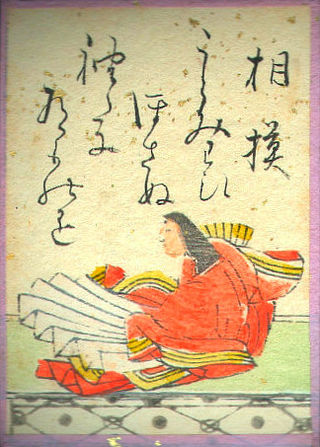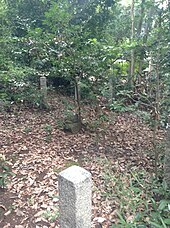
The Kokin Wakashū, commonly abbreviated as Kokinshū (古今集), is an early anthology of the waka form of Japanese poetry, dating from the Heian period. An imperial anthology, it was conceived by Emperor Uda and published by order of his son Emperor Daigo in about 905. Its finished form dates to c. 920, though according to several historical accounts the last poem was added to the collection in 914.

Ki no Tsurayuki was a Japanese author, poet and court noble of the Heian period. He is best known as the principal compiler of the Kokin Wakashū, also writing its Japanese Preface, and as a possible author of the Tosa Diary, although this was published anonymously. He is well known for his waka poetry and is counted as one of the Thirty-six Poetry Immortals selected by Fujiwara no Kintō; his poetry was included also in the Hyakunin Isshu. As a courtier, he served as Governor of Tosa (930–935), Vice Governor of Kaga (917–923) and Vice Governor of Mino Province (918–923).

Ono no Komachi was a Japanese waka poet, one of the Rokkasen—the six best waka poets of the early Heian period. She was renowned for her unusual beauty, and Komachi is today a synonym for feminine beauty in Japan. She also counts among the Thirty-six Poetry Immortals.

Hyakunin Isshu (百人一首) is a classical Japanese anthology of one hundred Japanese waka by one hundred poets. Hyakunin isshu can be translated to "one hundred people, one poem [each]"; it can also refer to the card game of uta-garuta, which uses a deck composed of cards based on the Hyakunin Isshu.
The Imakagami is a Japanese rekishi-monogatari written in the late Heian period. It is also called the Kokagami or the Shoku-Yotsugi.

The Tales of Ise is a Japanese uta monogatari, or collection of waka poems and associated narratives, dating from the Heian period. The current version collects 125 sections, with each combining poems and prose, giving a total of 209 poems in most versions.

Fujiwara no Kintō, also known as Shijō-dainagon, was a Japanese poet, admired by his contemporaries and a court bureaucrat of the Heian period. His father was the regent Fujiwara no Yoritada and his son Fujiwara no Sadayori. An exemplary calligrapher and poet, he is mentioned in works by Murasaki Shikibu, Sei Shōnagon and in a number of other major chronicles and texts.

The Thirty-Six Immortals of Poetry are a group of Japanese poets of the Asuka, Nara, and Heian periods selected by Fujiwara no Kintō as exemplars of Japanese poetic ability. The oldest surviving collection of the 36 poets' works is Nishi Honganji Sanju-rokunin Kashu of 1113. Similar groups of Japanese poets include the Kamakura period Nyōbō Sanjūrokkasen (女房三十六歌仙), composed by court ladies exclusively, and the Chūko Sanjūrokkasen (中古三十六歌仙), or Thirty-Six Heian-era Immortals of Poetry, selected by Fujiwara no Norikane (1107–1165). This list superseded an older group called the Six Immortals of Poetry.
The Rokkasen are six Japanese poets of the mid-ninth century who were named by Ki no Tsurayuki in the kana and mana prefaces to the poetry anthology Kokin wakashū as notable poets of the generation before its compilers.

Waka is a type of poetry in classical Japanese literature. Although waka in modern Japanese is written as 和歌, in the past it was also written as 倭歌, and a variant name is yamato-uta (大和歌).

Chōyaku Hyakunin Isshu: Uta Koi is a Japanese historical Josei manga written and illustrated by Kei Sugita, and published by Media Factory. An anime adaptation by TYO Animations began airing in July 2012.

Fujiwara no Michimasa was a mid-Heian period Imperial court noble and poet. He is included in the Hyakunin Isshu and was the nephew of Emperor Ichijo's wife, Empress Fujiwara no Teishi.

Ōe no Chisato (大江千里) was a Japanese waka poet and Confucian scholar of the late ninth and early tenth centuries. His exact birth and death dates are unknown but he flourished around 889 to 923. He was one of the Chūko Sanjūrokkasen and one of his poems was included in the Ogura Hyakunin Isshu.

Fujiwara no Kiyosuke was a Japanese waka poet and poetry scholar of the late Heian period.

Daini no Sanmi was a Japanese waka poet of the mid-Heian period.

Sagami, also known as Oto-jijū (乙侍従), was a Japanese waka poet of the mid-Heian period. One of her poems was included in the Ogura Hyakunin Isshu. She produced a private collection, the Sagami-shū.

Shun'e, also known as Tayū no Kimi (大夫公), was a Japanese waka poet of the late-Heian period. One of his poems was included in the Ogura Hyakunin Isshu. He produced a private collection, the Rin'yō Wakashū, and was listed as one of the Late Classical Thirty-Six Immortals of Poetry.

Ōe no Otondo was a Japanese courtier, Confucian scholar and kanshi poet of the early Heian period.
Ariwara no Motokata was a Japanese waka poet of the early Heian period.























